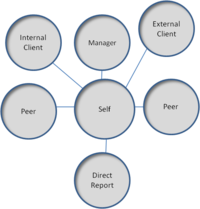Difference between revisions of "360 degree feedback"
(What is 360 Degree Feedback) |
|||
| Line 1: | Line 1: | ||
| − | In human resources or industrial psychology, 360-degree feedback, also known as multi-rater feedback, multi source feedback, or multi source assessment, is feedback that comes from members of an employee's immediate work circle. Most often, 360-degree feedback will include direct feedback from an employee's subordinates, peers (colleagues), and supervisor(s), as well as a self-evaluation. It can also include, in some cases, feedback from external sources, such as customers and suppliers or other interested stakeholders. It may be contrasted with "upward feedback," where managers are given feedback only by their direct reports, or a "traditional [[Performance-Appraisal|performance appraisal]]," where the employees are most often reviewed only by their managers. <ref>Definition of 360 Degree Feedback | + | In human resources or industrial psychology, 360-degree feedback, also known as multi-rater feedback, multi source feedback, or multi source assessment, is feedback that comes from members of an employee's immediate work circle. Most often, 360-degree feedback will include direct feedback from an employee's subordinates, peers (colleagues), and supervisor(s), as well as a self-evaluation. It can also include, in some cases, feedback from external sources, such as customers and suppliers or other interested stakeholders. It may be contrasted with "upward feedback," where managers are given feedback only by their direct reports, or a "traditional [[Performance-Appraisal|performance appraisal]]," where the employees are most often reviewed only by their managers. |
| + | |||
| + | <ref>E. Miller, ''The Sun'', (New York: Academic Press, 2005), 23-5.</ref> | ||
| + | <ref>Definition of 360 Degree Feedback [https://en.wikipedia.org/wiki/360-degree_feedback|Wikipedia]</ref> | ||
'''360 Degree - A Diagrammatic Overview''' | '''360 Degree - A Diagrammatic Overview''' | ||
| − | [[ | + | [[File:360_Degree_Eval_Diagram.png|200px|360 Degree Evaluation]]<br /> |
Source: [[http://www.cioindex.com/article/articleid/23216/effective-employee-performance-appraisal-system|CIO Index]] | Source: [[http://www.cioindex.com/article/articleid/23216/effective-employee-performance-appraisal-system|CIO Index]] | ||
Revision as of 14:33, 18 November 2018
In human resources or industrial psychology, 360-degree feedback, also known as multi-rater feedback, multi source feedback, or multi source assessment, is feedback that comes from members of an employee's immediate work circle. Most often, 360-degree feedback will include direct feedback from an employee's subordinates, peers (colleagues), and supervisor(s), as well as a self-evaluation. It can also include, in some cases, feedback from external sources, such as customers and suppliers or other interested stakeholders. It may be contrasted with "upward feedback," where managers are given feedback only by their direct reports, or a "traditional performance appraisal," where the employees are most often reviewed only by their managers.
360 Degree - A Diagrammatic Overview

Source: [Index]
[[image||Template:UPCanamWiki_Attachments/360-Project-Stages-300x285.png]]
Source: [[2]]
360 Degree Evaluation Sample
[[image||Template:UPCanamWiki_Attachments/360-evaluation-sample.jpg]] Source: [[3]]
See Also
References
